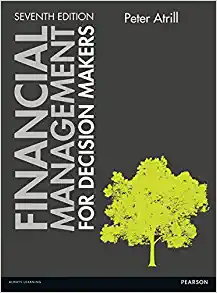Question
Classwork 1 - The Capital Asset Pricing Model: empirical tests Hand-in in week 4 1. Consider two stocks, A and B, with betas of 0.5
Classwork 1 - The Capital Asset Pricing Model: empirical tests
Hand-in in week 4
1. Consider two stocks, A and B, with betas of 0.5 and 1.5, respectively. You believe that the annualized expected return of the market is E[rM] = 10%, the annual standard deviation of the market is ?M = 0.20, and the risk-free rate is 5%. Finally, you believe that returns of A, B, and the market over the next year are represented by the regression:
(ri ? rf) = ?i + ?i(rM ? rf) + ei, for i = A, B
in which rA-rf is 0.04, rB-rf is 0.06, the R2 is 0.95 for both A and B, and where eA and eB are uncorrelated. Find the abnormal returns of these stocks (in excess of the returns predicted by the CAPM). Find the variance of portfolio P, composed of A and B with weights wA=70% and wB=30%.
2. Suppose that the index model for stocks A and B is estimated from excess returns with the following results:
RA =3%+.7RM+?A
RB = -2% + 1.2RM + ?B
?M = 20%
Rsq(A)=0.20
Rsq(B)=0.12;
a) What is the standard deviation of each stock?
b) Break down the variance of each stock into the systematic and firm-specific components.
c) What are the covariance and correlation coefficient between the two stocks?
d) Are the intercepts of the two regressions consistent with the CAPM? Interpret their values.
Note: in this classwork, the notation for returns and excess returns is the same as in your textbook: ri = return of stock I, Ri = ri - rf = excess return of stock
 The Capital Asset Pricing Model: empirical tests 1. Consider two stocks, A and B, with betas of 0.5 and 1.5, respectively. You believe that the annualized expected return of the market is E[rM] = 10%, the annual standard deviation of the market is M = 0.20, and the risk-free rate is 5%. Finally, you believe that returns of A, B, and the market over the next year are represented by the regression: (ri rf) = i + i(rM rf) + ei, for i = A, B in which rA-rf is 0.04, rB-rf is 0.06, the R2 is 0.95 for both A and B, and where eA and eB are uncorrelated. Find the abnormal returns of these stocks (in excess of the returns predicted by the CAPM). Find the variance of portfolio P, composed of A and B with weights wA=70% and wB=30%. 2. Suppose that the index model for stocks A and B is estimated from excess returns with the following results: RA =3%+.7RM+A RB = -2% + 1.2RM + B M = 20% Rsq(A)=0.20 Rsq(B)=0.12; a) What is the standard deviation of each stock? b) Break down the variance of each stock into the systematic and firm-specific components. c) What are the covariance and correlation coefficient between the two stocks? d) Are the intercepts of the two regressions consistent with the CAPM? Interpret their values. Note: in this classwork, the notation for returns and excess returns is the same as in your textbook: ri = return of stock I, Ri = ri - rf = excess return of stock
The Capital Asset Pricing Model: empirical tests 1. Consider two stocks, A and B, with betas of 0.5 and 1.5, respectively. You believe that the annualized expected return of the market is E[rM] = 10%, the annual standard deviation of the market is M = 0.20, and the risk-free rate is 5%. Finally, you believe that returns of A, B, and the market over the next year are represented by the regression: (ri rf) = i + i(rM rf) + ei, for i = A, B in which rA-rf is 0.04, rB-rf is 0.06, the R2 is 0.95 for both A and B, and where eA and eB are uncorrelated. Find the abnormal returns of these stocks (in excess of the returns predicted by the CAPM). Find the variance of portfolio P, composed of A and B with weights wA=70% and wB=30%. 2. Suppose that the index model for stocks A and B is estimated from excess returns with the following results: RA =3%+.7RM+A RB = -2% + 1.2RM + B M = 20% Rsq(A)=0.20 Rsq(B)=0.12; a) What is the standard deviation of each stock? b) Break down the variance of each stock into the systematic and firm-specific components. c) What are the covariance and correlation coefficient between the two stocks? d) Are the intercepts of the two regressions consistent with the CAPM? Interpret their values. Note: in this classwork, the notation for returns and excess returns is the same as in your textbook: ri = return of stock I, Ri = ri - rf = excess return of stock Step by Step Solution
There are 3 Steps involved in it
Step: 1

Get Instant Access to Expert-Tailored Solutions
See step-by-step solutions with expert insights and AI powered tools for academic success
Step: 2

Step: 3

Ace Your Homework with AI
Get the answers you need in no time with our AI-driven, step-by-step assistance
Get Started


